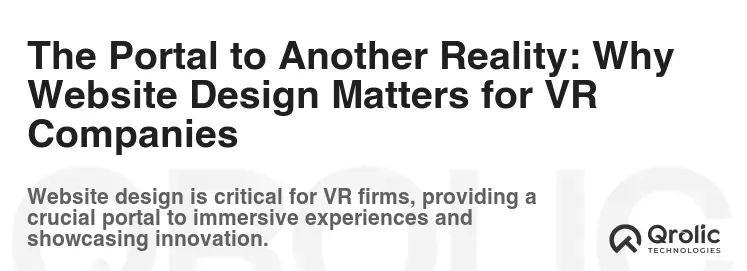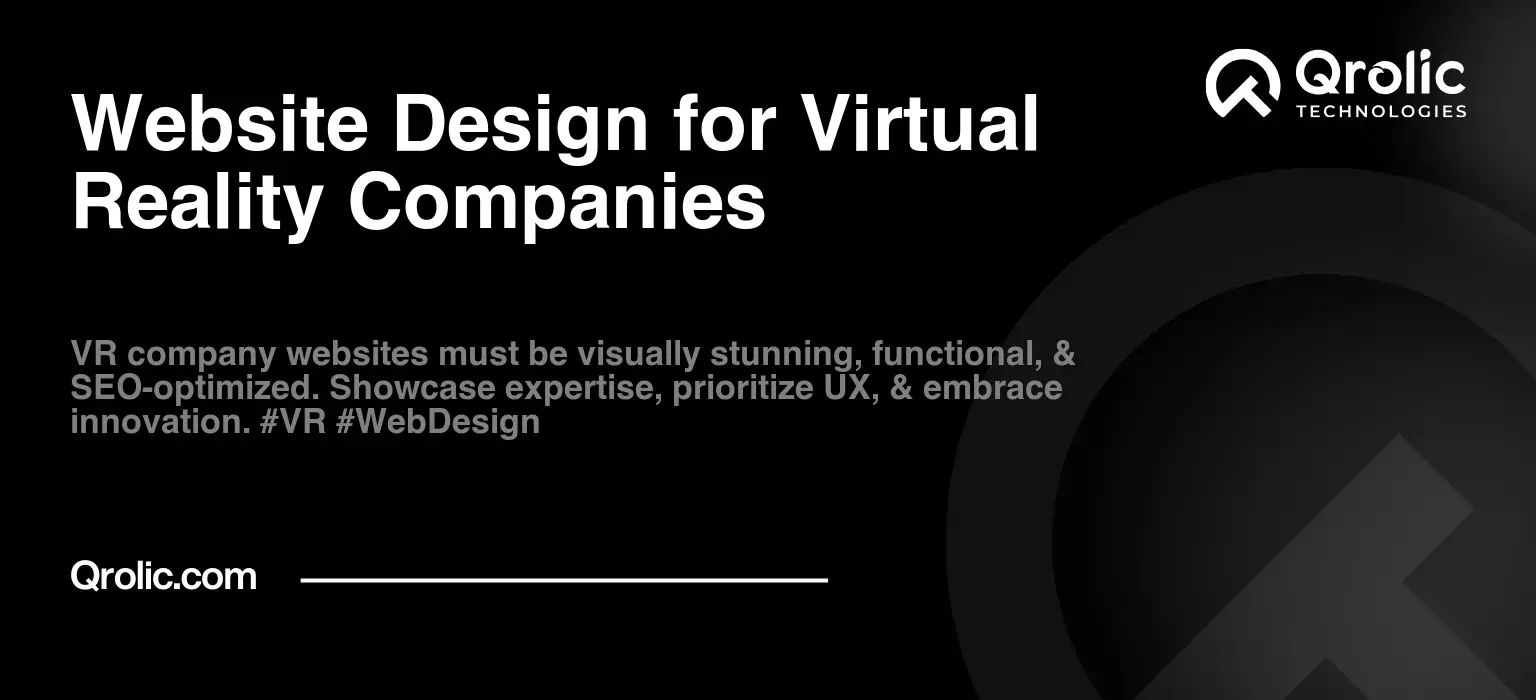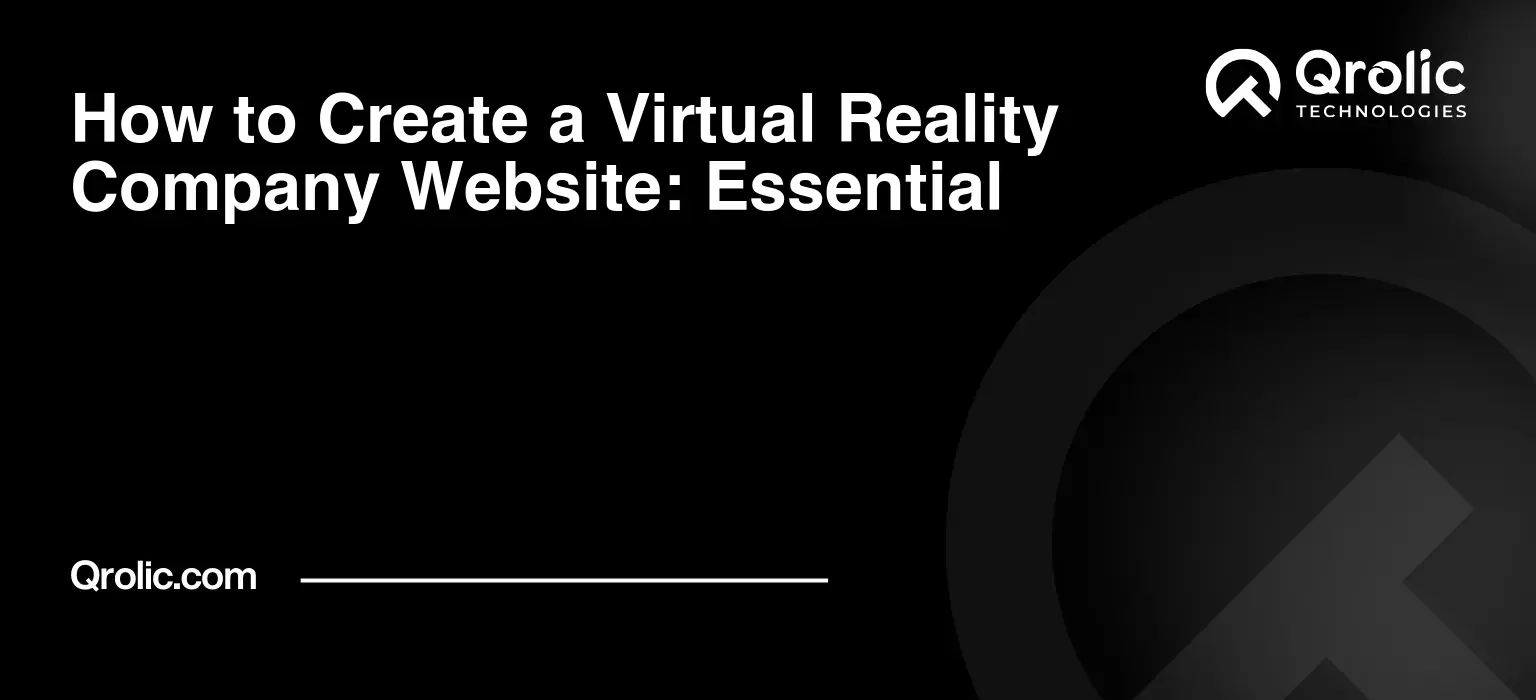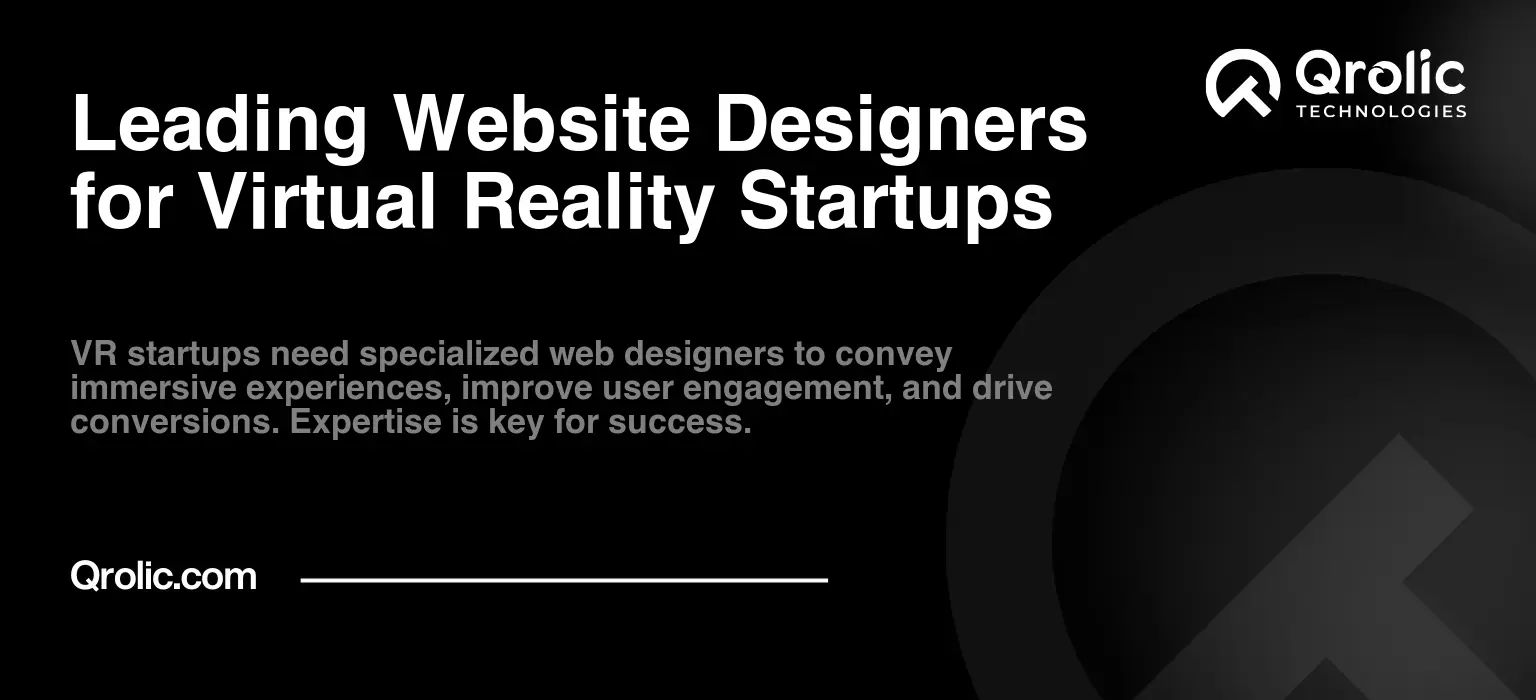Quick Summary:
- Make your VR website visually stunning and mobile-friendly.
- Ensure fast loading, clear navigation, and strong calls-to-action.
- Showcase expertise with valuable content and optimize for search.
- Highlight VR projects with rich visuals and embrace new technology.
Table of Contents
- The Portal to Another Reality: Why Website Design Matters for VR Companies
- The First Impression: Capturing the VR Aesthetic
- Beyond the Visuals: Functionality and User Experience
- Content is King (Even in VR)
- The Technical Backbone: Choosing the Right Platform
- SEO Optimization: Making Your VR Website Discoverable
- Showcasing Your VR Work: Portfolio Optimization
- Staying Ahead of the Curve: Embracing Emerging Technologies
- Measuring Success: Website Analytics and Optimization
- Legal Considerations for VR Company Websites
- Budgeting for Your VR Company Website
- The Future of VR Website Design
- Case Studies: Examples of Effective VR Company Websites
- Common Mistakes to Avoid in VR Company Website Design
- Qrolic Technologies: Your Partner in Immersive Tech Web Development
- The Final Frontier: Transforming Your VR Company with Exceptional Web Design
The Portal to Another Reality: Why Website Design Matters for VR Companies

In the burgeoning world of virtual reality (VR), where experiences transcend the physical, a company’s website acts as the initial gateway, the first glimpse into the immersive realms they create. It’s more than just a digital brochure; it’s a reflection of their innovation, their understanding of user experience, and their commitment to pushing the boundaries of reality. For VR companies, virtual reality website design isn’t just about aesthetics; it’s about conveying the very essence of their work.
The First Impression: Capturing the VR Aesthetic
The modern internet user has the attention span of a goldfish. Your VR company’s website has mere seconds to capture their interest and demonstrate your expertise. This means a website that instantly communicates the VR world.
- Visually Stunning Design: Think dynamic visuals, interactive elements, and a futuristic feel. The design should evoke the same sense of wonder and immersion that your VR experiences offer. Consider using:
- 3D elements: Showcase your VR environments and models directly on your website.
- Interactive animations: Engage visitors with subtle animations that mimic the fluidity of VR experiences.
- High-quality videos: Feature captivating videos showcasing your VR applications in action.
- Clean and Intuitive Navigation: A complex or cluttered website will drive visitors away. Ensure easy navigation with a clear menu structure and a logical flow of information. Think of it as designing a VR environment – intuitive movement and clear signposts are essential.
- Mobile Responsiveness: A significant portion of web traffic comes from mobile devices. Your website must be fully responsive and offer a seamless experience on smartphones and tablets. A poorly optimized mobile experience can severely damage your credibility.
Beyond the Visuals: Functionality and User Experience
A pretty website is useless if it doesn’t function correctly. The user experience (UX) is paramount. VR company website design needs to prioritize functionality and ease of use.
- Fast Loading Speed: In the digital age, speed is everything. slow loading times can lead to high bounce rates and a negative user experience. Optimize images, leverage browser caching, and choose a reliable hosting provider.
- Clear Call-to-Actions (CTAs): Guide visitors towards desired actions, such as requesting a demo, contacting your sales team, or downloading a whitepaper. Use strong, action-oriented language and visually prominent buttons. Examples include “Explore Our VR Solutions,” “Request a Demo,” or “Download Case Study.”
- Easy-to-Find Contact Information: Make it effortless for potential clients and partners to reach you. Prominently display your email address, phone number, and a contact form.
- Accessibility: Ensure your website is accessible to users with disabilities. Adhere to accessibility guidelines (WCAG) to make your content available to everyone.
Content is King (Even in VR)
While visuals are crucial, compelling content is what ultimately convinces visitors that you’re the right VR company for them.
- Showcase Your Expertise: Highlight your team’s skills and experience in VR development, design, and implementation. Include case studies and testimonials to demonstrate your capabilities.
- Explain Your VR Solutions: Clearly articulate the benefits of your VR applications. Explain how they solve specific problems or enhance existing processes in different industries. Use real-world examples and quantifiable results.
- Blog and News Section: Regularly publish informative and engaging content related to VR technology, industry trends, and your company’s latest developments. This establishes you as a thought leader and improves your website’s SEO.
- Whitepapers and eBooks: Offer in-depth resources that provide valuable insights into the world of VR. This can be a powerful lead generation tool.
The Technical Backbone: Choosing the Right Platform
The platform you choose for your website will significantly impact its performance and scalability.
- wordpress: A popular and versatile platform that offers a wide range of themes and plugins specifically designed for VR and technology companies. It’s relatively easy to use and offers excellent SEO capabilities.
- Webflow: A powerful visual development platform that allows you to create custom websites without coding. It’s ideal for VR companies that want a unique and highly customized online presence.
- Custom Development: If you have highly specific requirements or need advanced functionality, consider a custom-built website. This offers the most flexibility but can also be the most expensive option.
SEO Optimization: Making Your VR Website Discoverable
Even the most stunning website is useless if no one can find it. Search engine optimization (SEO) is crucial for driving organic traffic to your website. Virtual reality website design must consider SEO from the outset.
- Keyword Research: Identify the keywords and phrases that your target audience uses when searching for VR solutions. Use tools like Google Keyword Planner, SEMrush, and Ahrefs to find relevant keywords with high search volume and low competition. Keywords examples include:
- VR application development
- AR/VR solutions for training
- Immersive learning experiences
- Virtual reality simulations
- VR/AR content creation
- Augmented reality development services
- Mixed reality applications
- Extended reality (XR) development
- On-Page Optimization: Optimize your website’s content, meta descriptions, and title tags with relevant keywords. Ensure your website is structured logically and uses header tags (H1, H2, H3) appropriately.
- Off-Page Optimization: Build high-quality backlinks from reputable websites in the VR and technology industries. Participate in online communities and forums to establish your expertise.
- Technical SEO: Ensure your website is technically sound and easy for search engines to crawl and index. This includes optimizing your website’s loading speed, mobile responsiveness, and site architecture. Also ensure that your website is mobile-friendly, has an SSL certificate, and has a sitemap.
- Local SEO: If you serve a local market, optimize your website for local search. Create a Google My Business profile and include your address and phone number on your website.
Showcasing Your VR Work: Portfolio Optimization
Your portfolio is the centerpiece of your website, demonstrating your capabilities and attracting potential clients.
- High-Quality Visuals: Use professional-grade images and videos to showcase your VR projects. Capture the immersive experience and highlight the key features and benefits of your solutions.
- Detailed Case Studies: Provide in-depth descriptions of your VR projects, including the challenges you faced, the solutions you implemented, and the results you achieved.
- Client Testimonials: Include testimonials from satisfied clients to build trust and credibility.
- Categorization and Filtering: Make it easy for visitors to find relevant projects by categorizing them by industry, technology, or application.
- Interactive Demos: If possible, offer interactive demos or simulations that allow visitors to experience your VR solutions firsthand.
Staying Ahead of the Curve: Embracing Emerging Technologies
The VR industry is constantly evolving. Your website should reflect your commitment to innovation and your willingness to embrace new technologies.
- AR Integration: Consider incorporating augmented reality (AR) elements into your website to enhance the user experience. For example, you could allow visitors to visualize your VR solutions in their own environment using their smartphones.
- AI-Powered Chatbots: Implement AI-powered chatbots to provide instant support and answer frequently asked questions. This can improve customer satisfaction and free up your team to focus on more complex tasks.
- VR Website Experience: Explore the possibility of creating a VR version of your website that allows visitors to immerse themselves in your brand and explore your solutions in a virtual environment. This would be a truly innovative and memorable experience.
Measuring Success: Website Analytics and Optimization
Website design is not a one-time project. It’s an ongoing process of measurement, analysis, and optimization.
- Google Analytics: Track key metrics such as website traffic, bounce rate, time on page, and conversion rates.
- Heatmaps and User Recordings: Use tools like Hotjar and Crazy Egg to understand how visitors interact with your website. Identify areas where they are struggling or getting confused.
- A/B Testing: Experiment with different website elements, such as headlines, calls-to-action, and images, to see what performs best.
- Regular Updates: Keep your website content fresh and up-to-date. Regularly add new blog posts, case studies, and testimonials.
Legal Considerations for VR Company Websites
Ensuring your website complies with legal requirements is crucial to avoid potential issues.
- Privacy Policy: Clearly outline how you collect, use, and protect user data.
- Terms and Conditions: Define the terms of use for your website and protect your intellectual property.
- Accessibility Compliance: Adhere to accessibility guidelines (WCAG) to ensure your website is accessible to users with disabilities.
- GDPR and CCPA Compliance: If you collect data from users in the EU or California, ensure your website complies with GDPR and CCPA regulations.
Budgeting for Your VR Company Website
Website design costs can vary widely depending on the scope of the project, the complexity of the design, and the platform you choose.
- DIY Options: Using a website builder like Wix or Squarespace can be a cost-effective option for small VR companies with limited budgets.
- wordpress Theme Customization: Customizing a pre-built WordPress theme can be a more affordable alternative to custom website design.
- Professional Website Design: Hiring a professional web design agency or freelancer will provide you with a high-quality, custom-designed website that meets your specific needs.
- Ongoing Maintenance: Don’t forget to budget for ongoing website maintenance, including hosting, security updates, and content updates.
The Future of VR Website Design
VR website design is constantly evolving. Here are some trends to watch:
- Personalized Experiences: Websites will become increasingly personalized, tailoring content and experiences to individual users based on their preferences and behavior.
- Voice Search Optimization: As voice search becomes more popular, websites will need to be optimized for voice queries.
- Immersive Storytelling: Websites will use immersive storytelling techniques to engage visitors and create memorable experiences.
- Decentralized Web (Web3): Blockchain and decentralized technologies may impact the future of website design, offering new possibilities for security, privacy, and user ownership.
Case Studies: Examples of Effective VR Company Websites
Analyzing successful VR company websites can provide valuable insights and inspiration.
- Example 1 (Focus on Visual Immersion): [Insert Example of a website with stunning 3D visuals and interactive elements]. Analyze their use of imagery, animations, and overall aesthetic.
- Example 2 (Focus on Functionality and UX): [Insert Example of a website with a clean, intuitive interface and fast loading speed]. Analyze their navigation, call-to-actions, and accessibility features.
- Example 3 (Focus on Content and Expertise): [Insert Example of a website with a comprehensive blog, case studies, and whitepapers]. Analyze their content strategy and how they showcase their expertise.
Common Mistakes to Avoid in VR Company Website Design
- Ignoring Mobile Responsiveness: Failing to optimize your website for mobile devices.
- slow Loading Speeds: Neglecting to optimize images and code, resulting in slow loading times.
- Poor Navigation: Creating a confusing and difficult-to-navigate website.
- Lack of Clear Call-to-Actions: Failing to guide visitors towards desired actions.
- Outdated Content: Not regularly updating your website with fresh content.
- Ignoring SEO: Neglecting to optimize your website for search engines.
Qrolic Technologies: Your Partner in Immersive Tech Web Development
At Qrolic Technologies (https://qrolic.com/), we understand the unique challenges and opportunities that VR companies face when it comes to website design and immersive tech web development. We specialize in creating cutting-edge websites that capture the essence of your VR experiences and drive business growth.
Our Services:
- VR/AR Website Design & Development: We design and develop custom websites that showcase your VR/AR solutions in a compelling and engaging way.
- Immersive Experience Development: We create interactive demos and simulations that allow visitors to experience your VR/AR solutions firsthand.
- SEO Optimization: We optimize your website for search engines to ensure that it ranks highly in search results.
- Content Creation: We create high-quality content that educates and engages your target audience.
- Website Maintenance & Support: We provide ongoing website maintenance and support to ensure that your website is always running smoothly.
Why Choose Qrolic Technologies?
- Expertise in VR/AR Technology: We have a deep understanding of VR/AR technology and its applications.
- Experienced Team: Our team of designers, developers, and marketers has years of experience in creating successful websites for technology companies.
- Custom Solutions: We provide custom solutions that are tailored to your specific needs and goals.
- Results-Driven Approach: We are committed to delivering results that drive business growth.
- Client-Focused: We prioritize our clients’ needs and work closely with them throughout the entire process.
Let Qrolic Technologies help you create a website that truly reflects the innovation and potential of your VR company. Contact us today to learn more about our services.
The Final Frontier: Transforming Your VR Company with Exceptional Web Design
Your website is the digital embodiment of your VR company. By prioritizing visual appeal, functionality, SEO, and a user-centric approach, you can create a powerful online presence that attracts customers, builds brand awareness, and ultimately drives the success of your business in the exciting world of virtual reality. Remember VR company website design is an investment, one that bridges the gap between your immersive creations and the real world.








